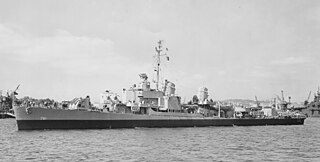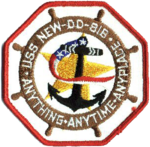
USS Barney (DD-956/DDG-6) was a Charles F. Adams-class guided missile destroyer in the United States Navy. She was the third Navy ship named for Commodore Joshua Barney USN (1759–1818).

USS Stickell (DD-888) was a Gearing-class destroyer of the United States Navy in service from 1945 to 1972. She was renamed HS Kanaris (D212) in 1972 on transfer to the Hellenic Navy.

USS Sampson (DDG-10), named for Admiral William T. Sampson USN (1840–1902), was a Charles F. Adams-class guided missile destroyer in the United States Navy.

USS Harwood (DD/DDE-861) was a Gearing-class destroyer of the United States Navy, in service from 1945 to 1971. She was transferred to Turkey on 17 December 1971 and sunk in error by Turkish aircraft on 21 July 1974.

USS Vogelgesang (DD-862) was a Gearing-class destroyer in the United States Navy. She was named for Rear Admiral Carl Theodore Vogelgesang USN (1869–1927).

USS Douglas H. Fox (DD-779) was an Allen M. Sumner-class destroyer of the United States Navy.

USS John W. Weeks (DD-701), an Allen M. Sumner-class destroyer, was named for John Wingate Weeks, who attained the rank of rear admiral. Weeks was elected to the United States House of Representatives where he served until entering the United States Senate in 1913. He became Secretary of War on 4 March 1921.

USS Charles H. Roan (DD-853) was a Gearing-class destroyer of the United States Navy. The ship was named after Charles Howard Roan, a United States Marine who lost his life in action on the island of Palau during World War II.

USS James C. Owens (DD-776), an Allen M. Sumner-class destroyer, is the only ship of the United States Navy FRAM II class to be named for Lieutenant James C. Owens Jr., a member of Torpedo Squadron 8 on board USS Hornet. His entire squadron was lost in an attack against Japanese aircraft carriers 4 June during the Battle of Midway. Lt. Owens received the Navy Cross and the Presidential Unit Citation (US) posthumously.

USS Robert K. Huntington (DD-781) was an Allen M. Sumner-class destroyer. It is the only ship of the United States Navy to have been named for Robert Kingsbury Huntington, a naval aviator and member of Torpedo Squadron 8. The entire squadron was lost during the Battle of Midway.

USS Lester (DE-1022) (1957–1973) was a United States Navy Dealey-class destroyer escort, named after Fred Faulkner Lester, a Navy Corpsman who was killed in action while assigned to the United States Marine Corps during the Battle of Okinawa in World War II. He was awarded the Medal of Honor posthumously for his heroic actions on 8 June 1945.

USS Macdonough (DLG-8/DDG-39) was a Farragut-class guided missile destroyer in the United States Navy. She was named for Commodore Thomas Macdonough, the 4th ship of the United States Navy to be named for him.

USS Norris (DD-859) was one of 98 Gearing-class destroyers in the United States Navy during the end of World War II. Norris was active from 9 June 1945 to 4 December 1970. Although built too late to see action during the war, the ship served in the Pacific, Atlantic, Asiatic, and Mediterranean areas.

USS William M. Wood (DD/DDR-715) was a Gearing-class destroyer in the United States Navy during the final year of World War II. She was in commission for 31 years, from 1945 through 1976, serving in both the Pacific and Atlantic Fleets. She was the second Navy ship named for Navy Surgeon-General William M. Wood (1809–1880).

The third USS Keppler (DD/DDE-765) was a Gearing-class destroyer in the United States Navy during the Korean War and the Vietnam War. She was named for Boatswain's Mate First Class Reinhardt J. Keppler (1918–1942), who was posthumously awarded the Medal of Honor for "extraordinary heroism" during the Naval Battle of Guadalcanal.

The third USS Lloyd Thomas (DD/DDE-764) was a Gearing-class destroyer in the United States Navy during the Korean War and the Vietnam War.

USS Basilone (DD/DDE-824) was a Gearing-class destroyer of the United States Navy, named for Gunnery Sergeant John Basilone (1916–1945), who was awarded the Medal of Honor for "extraordinary heroism and conspicuous gallantry in action...." in the defense of Henderson Field during the 1942 Guadalcanal campaign.

USS Robert A. Owens (DD/DDK/DDE-827) was a Gearing-class destroyer of the United States Navy, in service from 1949 to 1982. The ship was named for United States Marine Corps Medal of Honor recipient Robert A. Owens. The ship was then transferred to Turkey through the Security Assistance Program (SAP) and served as TCG Alcitepe (D-346). The destroyer was finally decommissioned in 1999 and scrapped.

USS Robert L. Wilson (DD/DDE-847) was a Gearing-class destroyer of the United States Navy, named for Marine Private First Class Robert L. Wilson (1920–1944), who was posthumously awarded the Medal of Honor for "conspicuous gallantry" in the Battle of Tinian.

USS Waccamaw (AO-109) was a Cimarron-class replenishment oiler in the United States Navy. She was named after Waccamaw River. The original capacity was 146,000 barrels (23,200 m3).





















